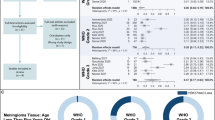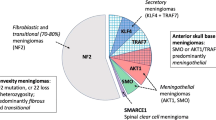Abstract
Epigenetic patterns on the level of DNA methylation have already been shown to separate clinically relevant subgroups of meningiomas. We here set out to identify potential prognostic implications of epigenetic modification on the level of histones with focus on H3K27 trimethylation (H3K27me3). H3K27me3 was assessed by immunohistochemistry on 232 meningiomas from 232 patients. In 194 cases, trimethylation was detected in tumor cells. In 25 cases, staining was limited to vessels while all tumor cells were negative. Finally, 13 cases yielded equivocal staining patterns. Reduced abundance of H3K27me3 in cases with staining limited to vessels was confirmed by mass spectrometry on a subset of cases. Lack of staining for H3K27me3 in all tumor cells was significantly associated with more rapid progression (p = 0.009). In line, H3K27me3-negative cases were associated with a DNA methylation pattern of the more aggressive types among the recently introduced DNA methylation groups. Also, NF2 and SUFU mutations were enriched among cases with complete lack of H3K27me3 staining in tumor cells (p < 0.0001 and p = 0.029, respectively). H3K27me3 staining pattern added significant prognostic insight into WHO grade II cases and in the compound subset of WHO grade I and II cases (p = 0.04 and p = 0.007, respectively). However, it did not further stratify within WHO grade III cases. Collectively, these data indicate that epigenetic modifications beyond DNA methylation are involved in the aggressiveness of meningioma. It also suggests that H3K27me3 immunohistochemistry might be a useful adjunct in meningioma diagnostics, particularly for cases with WHO grade II histology or at the borderline between WHO grade I and II.



Similar content being viewed by others
References
Bender S, Tang Y, Lindroth AM et al (2013) Reduced H3K27me3 and DNA hypomethylation are major drivers of gene expression in K27M mutant pediatric high-grade gliomas. Cancer Cell 24:660–672
Bi WL, Greenwald NF, Abedalthagafi M et al (2017) Genomic landscape of high-grade meningiomas. NPJ Genom Med 2. https://doi.org/10.1038/s41525-017-0014-7
Brastianos PK, Horowitz PM, Santagata S et al (2013) Genomic sequencing of meningiomas identifies oncogenic SMO and AKT1 mutations. Nat Genet 45:285–289
Cao R, Wang L, Wang H et al (2002) Role of histone H3 lysine 27 methylation in Polycomb-group silencing. Science 298:1039–1043
Clark VE, Erson-Omay EZ, Serin A et al (2013) Genomic analysis of non-NF2 meningiomas reveals mutations in TRAF7, KLF4, AKT1, and SMO. Science 339:1077–1080
Cleven AH, Al Sannaa GA, Briaire-de Bruijn I et al (2016) Loss of H3K27 tri-methylation is a diagnostic marker for malignant peripheral nerve sheath tumors and an indicator for an inferior survival. Mod Pathol 29:582–590
Di Vinci A, Brigati C, Casciano I et al (2012) HOXA7, 9, and 10 are methylation targets associated with aggressive behavior in meningiomas. Transl Res 160:355–362
Gao F, Shi L, Russin J et al (2013) DNA methylation in the malignant transformation of meningiomas. PLoS ONE 8:e54114
Garcia BA, Mollah S, Ueberheide BM et al (2007) Chemical derivatization of histones for facilitated analysis by mass spectrometry. Nat Protoc 2:933–938
Goldbrunner R, Minniti G, Preusser M et al (2016) EANO guidelines for the diagnosis and treatment of meningiomas. Lancet Oncol 17:e383–e391
Goutagny S, Nault JC, Mallet M, Henin D, Rossi JZ, Kalamarides M (2014) High incidence of activating TERT promoter mutations in meningiomas undergoing malignant progression. Brain Pathol 24:184–189
Harmanci AS, Youngblood MW, Clark VE et al (2017) Integrated genomic analyses of de novo pathways underlying atypical meningiomas. Nat Commun 8:14433
Heinze G, Schemper M (2001) A solution to the problem of monotone likelihood in Cox regression. Biometrics 57:114–119
Juratli TA, Thiede C, Koerner MVA et al (2017) Intratumoral heterogeneity and TERT promoter mutations in progressive/higher-grade meningiomas. Oncotarget 8:109228–109237
Karczmarski J, Rubel T, Paziewska A et al (2014) Histone H3 lysine 27 acetylation is altered in colon cancer. Clin Proteom 11:24
Kishida Y, Natsume A, Kondo Y et al (2012) Epigenetic subclassification of meningiomas based on genome-wide DNA methylation analyses. Carcinogenesis 33:436–441
Kondo Y, Shen L, Cheng AS et al (2008) Gene silencing in cancer by histone H3 lysine 27 trimethylation independent of promoter DNA methylation. Nat Genet 40:741–750
Louis DN, Perry A, Reifenberger G et al (2016) The 2016 World Health Organization classification of tumors of the central nervous system: a summary. Acta Neuropathol 131:803–820
MacLean B, Tomazela DM, Shulman N et al (2010) Skyline: an open source document editor for creating and analyzing targeted proteomics experiments. Bioinformatics 26:966–968
Nekrasov M, Klymenko T, Fraterman S et al (2007) Pcl-PRC2 is needed to generate high levels of H3–K27 trimethylation at Polycomb target genes. EMBO J 26:4078–4088
Olar A, Wani KM, Wilson CD et al (2017) Global epigenetic profiling identifies methylation subgroups associated with recurrence-free survival in meningioma. Acta Neuropathol 133:431–444
Panwalkar P, Clark J, Ramaswamy V et al (2017) Immunohistochemical analysis of H3K27me3 demonstrates global reduction in group-A childhood posterior fossa ependymoma and is a powerful predictor of outcome. Acta Neuropathol 134:705–714
Peyre M, Gauchotte G, Giry M et al (2017) De novo and secondary anaplastic meningiomas: a study of clinical and histomolecular prognostic factors. Neuro Oncol. https://doi.org/10.1093/neuonc/nox231
Puppe J, Drost R, Liu X et al (2009) BRCA1-deficient mammary tumor cells are dependent on EZH2 expression and sensitive to Polycomb Repressive Complex 2-inhibitor 3-deazaneplanocin A. Breast Cancer Res 11:R63
Reuss DE, Habel A, Hagenlocher C et al (2014) Neurofibromin specific antibody differentiates malignant peripheral nerve sheath tumors (MPNST) from other spindle cell neoplasms. Acta Neuropathol 127:565–572
Reuss DE, Piro RM, Jones DT et al (2013) Secretory meningiomas are defined by combined KLF4 K409Q and TRAF7 mutations. Acta Neuropathol 125:351–358
Rohrich M, Koelsche C, Schrimpf D et al (2016) Methylation-based classification of benign and malignant peripheral nerve sheath tumors. Acta Neuropathol 131:877–887
Rothbart SB, Dickson BM, Raab JR et al (2015) An interactive database for the assessment of histone antibody specificity. Mol Cell 59:502–511
Sahm F, Schrimpf D, Olar A et al (2016) TERT promoter mutations and risk of recurrence in meningioma. J Natl Cancer Inst 108(5):djv377. https://doi.org/10.1093/jnci/djv377
Sahm F, Schrimpf D, Stichel D et al (2017) DNA methylation-based classification and grading system for meningioma: a multicentre, retrospective analysis. Lancet Oncol 18:682–694
Schlesinger Y, Straussman R, Keshet I et al (2007) Polycomb-mediated methylation on Lys27 of histone H3 pre-marks genes for de novo methylation in cancer. Nat Genet 39:232–236
Shankar GM, Abedalthagafi M, Vaubel RA et al (2017) Germline and somatic BAP1 mutations in high-grade rhabdoid meningiomas. Neuro Oncol 19:535–545
Strickland MR, Gill CM, Nayyar N et al (2017) Targeted sequencing of SMO and AKT1 in anterior skull base meningiomas. J Neurosurg 127:438–444
Van Buuren S, Groothuis-Oudshoorn K (2011) mice: Multivariate imputation by chained equations in R. J Stat Softw 45(3):1–67
Vengoechea J, Sloan AE, Chen Y et al (2013) Methylation markers of malignant potential in meningiomas. J Neurosurg 119:899–906
Viré E, Brenner C, Deplus R et al (2006) The Polycomb group protein EZH2 directly controls DNA methylation. Nature 439:871–874
Wei Y, Xia W, Zhang Z et al (2008) Loss of trimethylation at lysine 27 of histone H3 is a predictor of poor outcome in breast, ovarian, and pancreatic cancers. Mol Carcinog 47:701–706
Yesiloz U, Kirches E, Hartmann C et al (2017) Frequent AKT1E17K mutations in skull base meningiomas are associated with mTOR and ERK1/2 activation and reduced time to tumor recurrence. Neuro Oncol 19:1088–1096
Yoo KH, Hennighausen L (2012) EZH2 methyltransferase and H3K27 methylation in breast cancer. Int J Biol Sci 8:59–65
Yu J, Yu J, Rhodes DR et al (2007) A polycomb repression signature in metastatic prostate cancer predicts cancer outcome. Can Res 67:10657–10663
Acknowledgements
The study was supported by grants of the German Cancer Aid (110983, 110670) and the “Else Kröner-Fresenius Stiftung” (2015_A60). We thank Laura Dörner, Antje Habel, Lisa Kreinbihl, and Hai Yen Nguyen for skillful technical assistance.
Author information
Authors and Affiliations
Corresponding author
Electronic supplementary material
Below is the link to the electronic supplementary material.
Rights and permissions
About this article
Cite this article
Katz, L.M., Hielscher, T., Liechty, B. et al. Loss of histone H3K27me3 identifies a subset of meningiomas with increased risk of recurrence. Acta Neuropathol 135, 955–963 (2018). https://doi.org/10.1007/s00401-018-1844-9
Received:
Revised:
Accepted:
Published:
Issue Date:
DOI: https://doi.org/10.1007/s00401-018-1844-9




